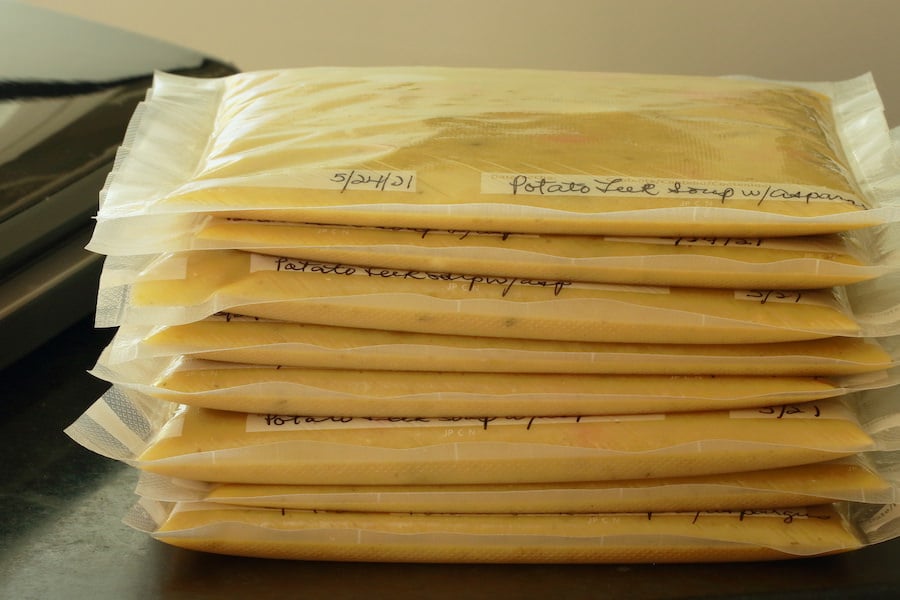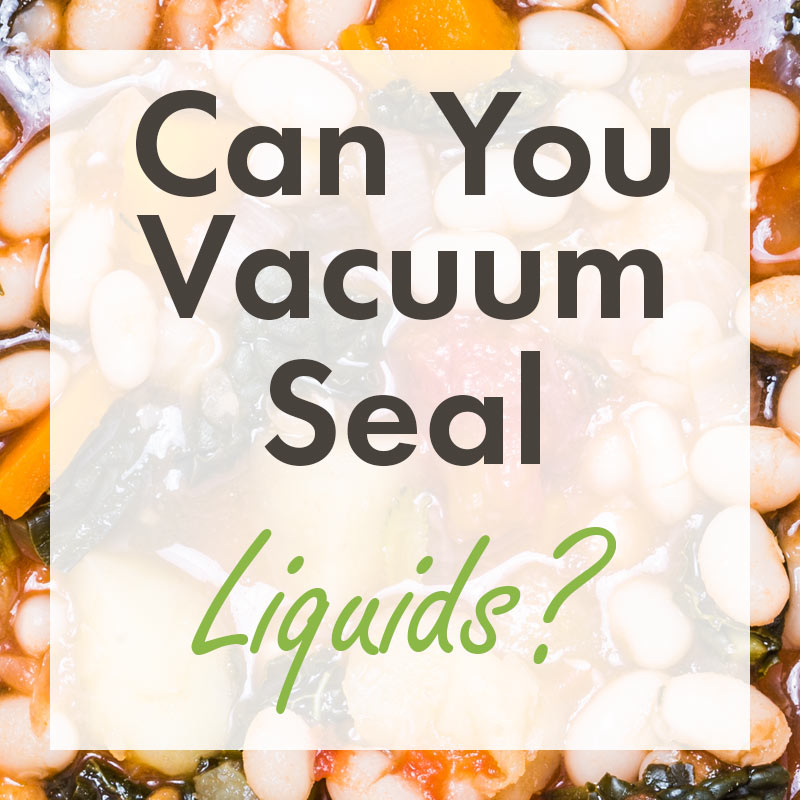As an Amazon Associate, I earn from qualifying purchases
To vacuum seal liquids, freeze them first or use a chamber vacuum sealer. Avoid overfilling bags to prevent spillage.
Vacuum sealing liquids can be a tricky endeavor, but with the right techniques, it’s a manageable task that can extend the shelf life of soups, stews, marinades, and other liquid-rich foods. By employing a chamber vacuum sealer, you can effortlessly seal liquids without the mess.
For those using a standard vacuum sealer, a simple trick is to freeze the liquid beforehand, transforming it into a solid state that’s much easier to handle. This approach ensures a clean seal without the risk of the liquid being sucked into the vacuum mechanism. Properly sealed liquids can be stored in the freezer or fridge, retaining freshness and flavor for future use. Embracing this method elevates your food preservation game, saving both time and money while minimizing waste.

Credit: alifewellplanted.com
The Basics Of Vacuum Sealing Liquids
Vacuum sealing is a technique to extend the shelf life of food items. It involves removing air before sealing the packaging. With liquids, this method can be tricky but very beneficial. Let’s dive into the process and learn how to do it right.
Benefits Of Vacuum Sealing
- Longer shelf life: Vacuum sealing prevents spoilage.
- Flavor preservation: It keeps tastes intact.
- Space efficiency: Sealed bags take up less room.
- Prevents freezer burn: No air means no ice crystals.
Challenges With Liquids
Sealing liquids is not without its hurdles. Machines can suck up the liquid, creating a mess. Freezing first or using the right techniques can solve this.
| Challenge | Solution |
|---|---|
| Liquid getting sucked into the vacuum sealer | Freeze the liquid slightly or use a moist setting if available |
| Seal not holding | Double seal the edge for extra security |
| Bag wrinkles causing leaks | Smooth out the bag before sealing |
Selecting The Right Equipment
Selecting the Right Equipment is crucial when vacuum sealing liquids. The task demands specific tools to avoid mess and ensure a perfect seal every time.
Vacuum Sealer Types For Liquids
Not all vacuum sealers handle liquids well. Here’s what to look for:
- Chamber Vacuum Sealers – Best for liquids. They remove air from the whole chamber, not just the bag.
- External Vacuum Sealers – These need careful handling. Freeze liquids first or use accessories.
Essential Accessories
Accessories can make or break the sealing process. Consider these:
| Accessory | Function |
|---|---|
| Sealing Canisters | Seal liquids without a bag. Great for soups and stews. |
| Liquid Blockers | Prevent liquids from getting sucked into the sealer. |
| Freezer-safe Bags | Use these to pre-freeze liquids. Makes sealing easier. |
Preparation Steps For Liquids
Proper preparation of liquids is crucial before vacuum sealing. This guide will help you get your liquids ready without a mess or fuss.
Choosing Containers
Selecting the right containers is vital for successful vacuum sealing of liquids. Here are the best options:
- Plastic vacuum seal bags: Ensure they are puncture-resistant.
- Mason jars: Ideal for vacuum sealing with a jar attachment.
- Rigid vacuum seal containers: Perfect for liquids that expand.
Always check for compatibility with your vacuum sealer model.
Pre-freezing Techniques
Pre-freezing liquids prevents mess during the sealing process. Follow these steps:
- Pour the liquid into an ice cube tray or a shallow pan.
- Let it freeze until solid.
- Transfer the frozen blocks into a vacuum seal bag or container.
- Vacuum seal the bag or container as usual.
This technique works great for soups, sauces, and even marinades.

Credit: www.invacus.com
Vacuum Sealing Process
The vacuum sealing process is a method to preserve food by removing air from the package before sealing. This technique extends the shelf life of foods and protects them from freezer burn and spoilage. When it comes to liquids, vacuum sealing requires a bit more care to prevent messes and ensure a perfect seal. Follow these steps for successful liquid preservation.
Filling The Bags
Begin by selecting the right bags. They should be compatible with your vacuum sealer. Use quality bags to avoid leaks and ensure a durable seal. Here’s how to fill them:
- Chill the liquid beforehand to reduce the risk of spillage.
- Fill the bags no more than half full to prevent overflow during the sealing process.
- Keep the top of the bag clean. Wipe off any residue with a paper towel.
- Place the bag upright, possibly using a holder or a container to keep it stable.
Sealing Best Practices
The sealing phase is crucial. Follow these best practices to seal your liquids safely:
- Place the open end of the bag in the vacuum sealer. Check that the bag is flat and the liquid is not near the top.
- Use the ‘moist’ setting if your machine has one. This setting is made for wet foods and liquids.
- Press the seal button and hold the bag if necessary to prevent the liquid from being sucked out.
- Once sealed, double-check the seal to ensure it is tight and has no gaps.
Store your vacuum-sealed liquids upright to minimize the risk of leaks.
Troubleshooting Common Issues
Vacuum sealing liquids can be tricky. Many users face issues while trying to preserve soups, stews, or marinades. This section will guide you through some common problems and solutions.
Avoiding Spills
Spills are the main concern when vacuum sealing liquids. Here’s how to prevent them:
- Use the pulse button if your vacuum sealer has one. It gives you control over the sealing process.
- Freeze the liquid slightly. It makes it less likely to spill out.
- Fill bags only to the recommended level. This leaves enough space for sealing.
Remember, a clean work area helps prevent mess and wasted product.
Maintaining Seal Integrity
A strong seal is crucial for preserving your liquids. Follow these steps to ensure your seal holds:
- Check the seal area for moisture. Wipe it if needed.
- Double-seal the bag. It provides an extra layer of protection.
- Inspect the seal after vacuuming. Make sure there are no gaps or weak spots.
A good seal keeps your liquids fresh and prevents freezer burn.
Creative Uses And Recipes
Vacuum sealing liquids unlocks a new world of culinary convenience and taste. Explore creative recipes and uses for this savvy kitchen technique.
Meal Prep And Storage
Efficient meal planning is a breeze with vacuum-sealed liquids. Say goodbye to spoiled ingredients and hello to freshness.
- Freeze soups and sauces for quick dinners.
- Portion smoothie mixes; grab, blend, and enjoy.
- Store homemade broths for weeks without loss of flavor.
Infusions And Marinades
Intensify flavors in meats and spirits with vacuum-sealed infusions and marinades.
| Infusion/Marinade | Ingredients | Time |
|---|---|---|
| Herb Oil | Olive oil, rosemary, thyme | 24 hours |
| Garlic Chicken | Garlic, soy sauce, chicken breasts | 12 hours |
| Berry Vodka | Strawberries, vodka | 48 hours |

Credit: foodvacbags.com
Frequently Asked Questions
Can You Seal Liquid In A Vacuum Sealer?
Yes, you can seal liquids with a vacuum sealer by freezing them first or using a canister attachment to prevent spillage.
How Do You Vacuum Seal Wet Ingredients?
Freeze wet ingredients slightly before sealing. Use paper towels to absorb excess moisture. Leave headspace in the bag. Double seal for extra protection. Choose a vacuum sealer with a wet mode if available.
How To Freeze Soup In A Vacuum Sealer?
Cool the soup completely before vacuum sealing. Pour into a sealer bag, leaving space at the top. Seal the bag, ensuring it’s airtight. Freeze flat for efficient storage.
How Do You Vacuum A Liquid?
To vacuum a liquid, use a wet-dry vacuum cleaner specifically designed for both solid and liquid messes. Ensure the vacuum has a liquid setting or attachment. Remove any standard filters used for dry materials before starting. Follow the manufacturer’s instructions to safely suck up the liquid.
Conclusion
Sealing liquids can be a breeze with the right technique and tools. Embrace the tips shared to master vacuum sealing, keeping your liquids fresh longer. From pre-freezing to using the right bags, your kitchen prowess will soar. Get ready to enjoy spill-free storage and an organized fridge or freezer.
Start vacuum sealing today and taste the difference!
As an Amazon Associate, I earn from qualifying purchases
